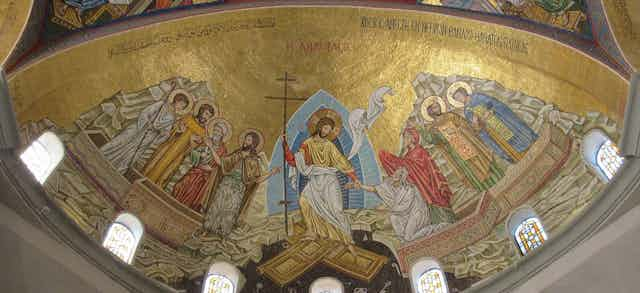As Easter approaches, Christians around the world begin to focus on two of the central tenets of their faith: the death and resurrection of Jesus of Nazareth.
Other charismatic Jewish teachers or miracle workers were active in Judea around the same time, approximately 2,000 years ago. What set Jesus apart was his followers’ belief in his resurrection. For believers, this was not only a miracle, but a sign that Jesus was the long-awaited Jewish messiah, sent to save the people of Israel from their oppressors.
But was the idea of a resurrection itself a unique belief in first-century Israel?
I am a scholar of ancient Judaism and its connection to the early Christian movement. The Christian concept of Jesus rising from the dead helped shape many of the faith’s key teachings and, ultimately, the new religion’s split from Judaism. Yet religious teachings about resurrection go back many centuries before Jesus walked the earth.
There are stories that likely predate early Jewish beliefs by many centuries, such as the Egyptian story of the god Osiris being resurrected by his wife, Isis. Most relevant for Christianity, though, are Judaism’s own ideas about resurrection.
‘Your dead shall live’
One of the earliest written Jewish references to resurrection in the Bible is found in the Book of Isaiah, which discusses a future era, perhaps a time of final judgment, in which the dead would rise and be subject to God’s ultimate justice. “Your dead shall live; their corpses shall rise,” Isaiah prophesies. “Those who dwell in the dust will awake and shout for joy.”

Later Jewish biblical texts such as the Book of Daniel also referenced resurrection.
There were several competing Jewish sects at the time of Jesus’ life. The most prominent and influential, the Pharisees, further integrated the concept of resurrection into Jewish thought. According to the first-century historian Josephus, the Pharisees believed that the soul was immortal and could be reunited with a resurrected body – ideas that would likely have made the idea of Jesus rising from the dead more acceptable to the Jews of his time.
Within a few centuries, the rabbis began to fuse together the earlier biblical references to bodily resurrection with the later ideas of the Pharisees. In particular, the rabbis began to discuss the concept of bodily resurrection and its connection to the messianic era.

Jews believed that the legitimate Messiah would be a descendant of the biblical King David who would vanquish their enemies and restore Israel to its previous glory. In the centuries following Jesus’ death, the rabbis taught that the souls of the dead would be resurrected after the Messiah appeared on earth.
By the 500s C.E. or so, the rabbis further elaborated upon the concept. The Talmud, the most important collection of authoritative writings on Jewish law apart from the Bible itself, notes that one who does not believe in resurrection has no share in the “Olam Haba,” the “World to Come.” The Olam Haba is the realm where these sages believed one’s soul eventually dwells after death. Interestingly, the concept of hell itself never became ingrained within mainstream Jewish thought.
Even now, the concept of God giving life to the dead is affirmed every day in the Amidah, a Jewish prayer recited as part of the daily morning, afternoon and evening services.
Old ideas, new beliefs
The fact that the first followers of Jesus were Jews likely contributed to the concept of resurrection becoming ingrained into Christian thought. Yet the Christian understanding of resurrection was taken to an unprecedented degree in the decades following Jesus’ death.
According to Matthew’s Gospel, Jesus, a Jew from Galilee, entered Jerusalem in the days before Passover. He was accused of sedition against the Roman authorities – and likely other charges, such as blasphemy – largely because he was causing a disturbance among the Jews getting ready to celebrate the holiday. At the time, Passover was a pilgrimage festival in which tens of thousands of Jews would travel to Jerusalem.
After being betrayed by one of his followers, Judas, Jesus was arrested, hastily put on trial and sentenced to be crucified. The Roman authorities wished to uphold the pax Romana, or Roman peace. They feared that unrest amid a major festival could lead to a rebellion, especially given the accusation that at least some of Jesus’ followers believed him to be the “King of the Jews, as was recorded later in Matthew’s and Mark’s Gospels.

According to the Gospels, Jesus was put to death on what is now Good Friday, and rose again on the third day – which today is celebrated as Easter Sunday.
Jesus’ early followers believed not only that he had been resurrected, but that he was the long-awaited Jewish messiah, who had fulfilled earlier Jewish prophecies. Eventually, they also embraced the idea that he was the divine Son of God, although scholars still debate exactly how and when this occurred.
In addition, the nature of Jesus’ resurrection remains a source of debate among theologians and scholars – such as whether followers believed his resurrected body was made of flesh and blood, or pure spirit.
Yet the grander meaning of the resurrection, which is recorded in all four canonical Gospels, remains clear for many of the approximately 2 billion Christians around the world: They believe that Jesus triumphed over death, which serves as a cornerstone foundation of the Christian faith.


